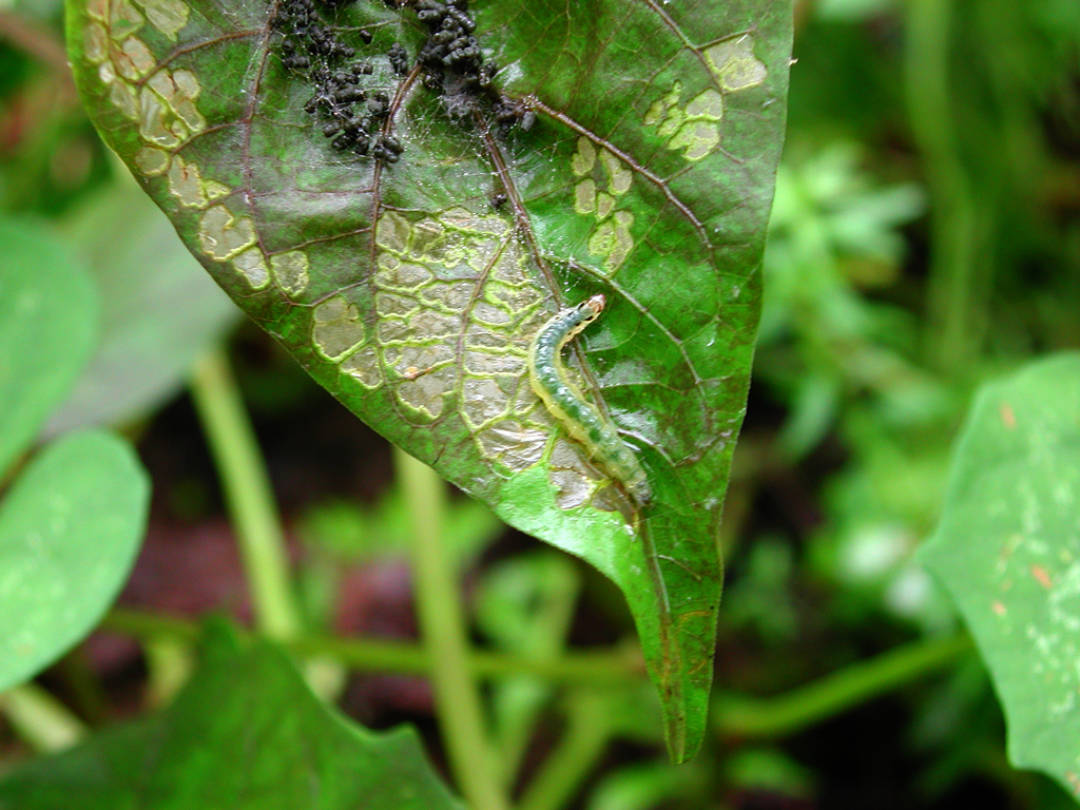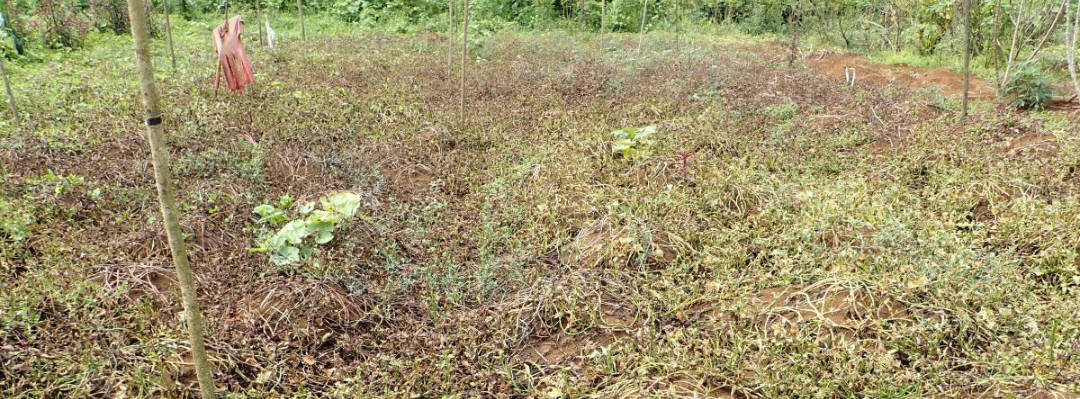Story by Fiona Burns
Rarumana is a village of five sub-villages on the island of Vonavona, Western Province, Solomon Islands. The Rarumana project was born out of a personal interest in international development and an issue that was identified on a trip to the nation in 2019.
I have family who have lived in Gizo for 30 years, and I have visited the Solomon Islands a number of times growing up, the latest being a field work trip in 2019, where I first came across the sweet potato issue in Rarumana.
Hearing the same problem, but what is the cause?
During my trip in 2019, I spent a couple of months travelling around Western Province talking to communities about agriculture and income. There was a range of issues that presented, such as wild pigs, unpredictable weather and soil erosion from logging. Of course, there were pest issues as well, but Rarumana was the only village that had a major issue with their sweet potato crop. It stuck in my mind as every person we spoke to had the same issue, and whatever it was serious, threatening their food and financial security. When I returned to Australia, I couldn’t stop thinking about it and decided to start the Rarumana project and connect with agriculture experts to see if anyone could help.
The aim was to identify the sweet potato pest and see if any education, training or other intervention could help to manage it. Initially, the plan was to go to the Solomon Islands to carry out data collection with local contacts, but COVID changed that in 2020. The project had to be implemented remotely in partnership with local people doing the field work.
Possibly leaf folders
Then in 2019, I contacted the Australian Centre for International Agricultural Research (ACIAR) to connect with people working in agriculture in Solomon Islands. I was put in contact with Grahame Jackson and Mike Furlong and shared with them what I had learnt from my trip. Grahame took the lead in educating me on what was known about pests in the country and province. He was unaware of the sweet potato issue in Rarumana and was keen to investigate further.

During our conversations I learnt of the report by Ellen Iramu and Tikai Pitakia on insect pest problems across Western Province. In 2016, they had been to West Parara, which is in the north of Vonavona island, and there identified a leaf folder caterpillar on sweet potato (see photo below). Even at that time the pest was devastating crops.

The initial identification by Ellen and Tikai was an interesting piece of the puzzle and added another part to the Rarumana project. Seeing the connection, we decided to incorporate a visit to West Parara to see if the problem I had been told about during my field work, and that was reported earlier by Ellen and Pita, was one and the same.
Funds, plans, lockdown and COVID
The connection also introduced me to TerraCircle, where I applied for a grant to fund the project. The financial assistance and connection were a great support. Having the backing of an organization in the country meant that there was value in the project and started more conversations about the issue.
So, in April 2021, I spoke to my local enumerator, Elai, about going to Rarumana and West Parara. He agreed.
However, organisation of the project was slow due to the limitations of conducting the project remotely as well as my workload in Australia, which significantly increased during COVID. But by January 2022, the first trip to Vonavona Island was set to go. Unfortunately, this coincided with the arrival of COVID in the Solomon Islands and the Rarumana community dealing with cases. We had to wait another 2 months before Elai set off, and finally met with Allen, Rarumana’s village leader and Hane, a teacher. Both were very receptive to the proposed investigation of the pest. Elai attempted to visit West Parara to check if the sweet potato crop still had the leaf folder problem identified by Ellen and Tikai, but the location of the village was not clear and was left to be confirmed by a future trip.
In Rarumana, a project to collect data on the pest was proposed to the community. It included school children in creating plots of sweet potato in the village to monitor the progression of the pest over a 12-week period. The kids would be looking for eggs, larvae, folded leaves and how far up the potato vine the issue occurred. The community was keen, and Hane would organize the children’s participation, watching over the crops and noting down changes.
Almost there, and guess what?
The project proposal was accepted by the village leader with plans to go back a couple of weeks after the initial visit to go through details. COVID then came back into the province, travel was on hold again, the village were getting their next round of vaccines, and communication was difficult. The project was delayed once more. In the background, work continued on the project design, purchasing materials and logistics while we waited for COVID to subside.
I then lost contact with Elai due to network issues. Pita was a great collaborator on the project, especially at this time, helping where he could and offering his services when he had a trip planned to Gizo. I tried to contact Pita to make the visit when contact with Elai was lost, but the cost for him to go to Rarumana was more than the whole grant. He also attempted to connect us to someone in Gizo who could assist, but it was difficult to find someone without adequate funding. Costs for field work in Western Province are high because there are no roads, and all visits have to be made by canoe and outboard motor.
Regional IPM steps in
Some months passed with no movement in the project. In that time, the pest had been discovered by Pita in Roviana Island. Grahame informed me that he and Mike were booked to visit Roviana with the Ministry of Agriculture and Livestock staff to inspect the extent of the sweet potato destruction. At this point, Grahame and I discussed what I would like to do with the project, considering that the issue was a lot larger than initially thought.
It was agreed to see what information was collected from the trip to Roviana and if the leftover funding could be used for a small community project in the future.
Findings from the trip to Rendova, Vona Vona and Kolombangara Islands were far more dire than normally associated with sweet potato leaf folder, a common pest in the crop. Farmers were attempting to target the caterpillars with pesticides but were not having luck. Further testing and training would have to be done with alternative products to help the communities save their crops. Due to the findings from the trip, there is a hope to visit New Georgia, Renonga, Vella la Vella and Choiseul to determine if the pest is there as well.
It was a shame that the project did not go as planned, but I was happy that the work that was done shed light on the issue. It is great that the Ministry of Agriculture and Livestock is now involved, and resources are being dedicated to looking into the problem. I am hoping that this means the pest will be investigated further and training or resources can be devoted to the issue.
The project was a huge learning curve as I do not come from an agriculture background, and it was the first time attempting to manage a project remotely. COVID and everything in those years of uncertainty proved to be a huge hurdle and challenge. The best part for me was connecting with amazing people like Grahame, Pita and Mike. It has been a pleasure to learn from them and be welcomed into a new sector with open arms. I could not have attempted the project without all the support, especially from Grahame.
I want to say a big thank you to our local enumerator, Elai. He was an integral part of the project, working hard in difficult circumstances. He was our eyes and ears on the ground, keeping us informed, which was an important piece of the project. I look forward to working on a project in the Solomon Islands again. I have really enjoyed the process overall, including the collaboration and learning. My hope is that the communities affected by the leaf folder are identified and supported to work towards a solution for this devastating pest.
Conclusions
If the difficulty of investigating major pest problems in other provinces of Solomon Islands is anything like that I experienced in Western Province, then the future does not bode well. What struck me was that it was only by a chance garden survey from a donor-funded project that the problem was discovered. And this did not lead to alarm bells ringing that something was not right and an urgent response was needed.
My attempts during a pandemic were obviously insufficient, and from the time of first recognition till expert investigation was 6 years. One can only hope that with the advent of mobile phones and widespread digital coverage that the next alien pest introduction will be reported sooner. The problem then will be how to deal with it in a country that has scarce resources to meet such events.

